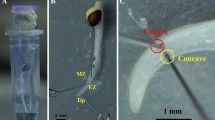Summary
Horizontally-placed segments of Avena sativa L. shoots show a negative geotropic response after a period of 30 min. This response is based on cell elongation on the lower side of the leaf-sheath base (pulvinus). Triticum aestivum L., Hordeum vulgare L. and Secale cereale L. also show geotropic responses that are similar to those in Avena shoots. The pulvinus is a highly specialized organ with radial symmetry and is made up of epidermal, vascular, parenchymatous and collenchymatous tissues. Statoliths, which are confined to parenchyma cells around the vascular bundles, sediment towards the gravitational field within 10–15 min of geotropic stimulation. Collenchymatous cells occur as prominent bundle caps, and in Avena, they occupy about 30% of the volume of the pulvinus. Geotropic stimulation causes a 3- to 5-fold increase in the length of the cells on the side nearest to the center of the gravitational field. Growth can also be initiated in vertically-held pulvini by the application of indole-3-acetic acid, 1-naphthaleneacetic acid or 2.4-dichlorophenoxyacetic acid. 2.3.5.-triiodobenzoic acid interferes with growth response produced by geotropic stimulation as well as with the response caused by auxin application. Gibberellic acid and kinetin have no visible effect on the growth of the pulvinus. Polarization microscopy shows a unique, non-uniform stretching of the elongating collenchymatous cells. Nonelongated collenchymatous cells appear uniformally anisotropic. After geotropic stimulation or auxin application, they appear alternately anisotropic and almost isotropic. Such a pattern of cell elongation is also observed in collenchyma cells of geotropically-stimulated shoots of Rumex acetosa L., a dicotyledon.
Similar content being viewed by others
Abbreviations
- 2.4-D:
-
2.4-dichlorophenoxyacetic acid
- GA3 :
-
gibberellic acid
- IAA:
-
indole-3-acetic acid
- NAA:
-
l-naphthaleneacetic acid
- TIBA:
-
2.3.5-triiodobenzoic acid
References
Anderson, D.B.: Über die Struktur der Kollenchymzellwand auf Grund mikrochemischer Untersuchungen. S.-B. Akad. Wiss. Wien, KI. Math. Naturwiss. 136, 429–439 (1927)
Arslan, N., Bennet-Clark, T.A.: Geotropic behaviour of grass nodes. J. exp. Bot. 11, 1–12 (1960)
Beer, M., Setterfield, G.: Fine structure in thickened primary walls of collenchyma cells of celery peteoles. Amer. J. Bot. 45, 571–580 (1958)
Bridges, I.G., Wilkins, M.B.: Growth initiation in the geotropic response of the wheat node. Planta (Berl.) 112, 191–200 (1973)
Brown, W.V., Pratt, G.A., Mobley, H.M.: Grass morphology and systematics. II. The nodal pulvinus. Southw. Naturalist 4, 126–130 (1959)
Czaja, A.T.: Neue Untersuchungen über die Struktur der partiellen Wandverdickungen von faserförmigen Kollenchymzellen. Planta (Berl.) 56, 109–124 (1961)
Duchaigne, A.: Les divers types de collenchymes chez les Dicotyledonés: leur ontogénie et leur lignification. Ann. Sci. nat., Bot., Sér. 11 16, 455–479 (1955)
Esau, K.: Plant anatomy, 2nd edn. New York-London-Sydney: Wiley 1965
Jensen, W.A.: Botanical histochemistry. San Francisco-London: Freeman 1962
Kaufman, P.B.: The effects of growth substances on intercalary growth and cellular differentiation in developing internodes of Avena sativa. II. The effects of gibberellic acid. Physiol. Plantarum (Cph.) 18, 703–724 (1965)
Kaufman, P.B.: Role of gibberellins in the control of intercalary growth and cellular differentiation in developing Avena internodes. Ann. N.Y. Acad. Sci. 144, 191–203 (1967)
Maeda, E.: The effects of growth regulators on the geotropism of the leaf sheath basal region in wheat. J. exp. Bot. 9, 343–349 (1958)
Maeda, E.: Geotropic reaction of excised rice leaves. Physiol. Plantarum (Cph.) 13, 204–213 (1960)
Majumdar, G.P., Preston, R.D.: The fine structure of collenchymacells in Heracleum sphondylium L. Proc. roy. Soc. B. 130, 201–217 (1942)
Preston, R.D., Duckworth, R.B.: The fine structure of the cell walls of collenchyma cells in Petasites vulgaris L. Proc. Leeds Philos. Soc. 4, 343–351 (1946)
Roland, J.C.: Organization de la membrane paraplasmique du collenchyme. J. Microscopy 5, 323–348 (1966)
Sachs, J.: Lectures on the physiology of plants. [Engl. transln.] Oxford: Clarendon Press 1887
Wardrop, A.B.: The structure of the cell wall in lignified collenchyma of Eryngium sp. (Umbelliferae). Aust. J. Bot. 17, 229–240 (1969)
Author information
Authors and Affiliations
Rights and permissions
About this article
Cite this article
Dayanandan, P., Hebard, F.V. & Kaufman, P.B. Cell elongation in the grass pulvinus in response to geotropic stimulation and auxin application. Planta 131, 245–252 (1976). https://doi.org/10.1007/BF00385422
Received:
Accepted:
Issue Date:
DOI: https://doi.org/10.1007/BF00385422




